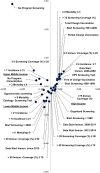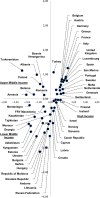HPV-vaccination and cancer cervical screening in 53 WHO European Countries: An update on prevention programs according to income level
- PMID: 30993902
- PMCID: PMC6536990
- DOI: 10.1002/cam4.2048
HPV-vaccination and cancer cervical screening in 53 WHO European Countries: An update on prevention programs according to income level
Abstract
Human papillomavirus (HPV) is the most common sexually transmitted disease in the world. The aim of our study is to describe the differences in HPV-vaccination coverage and screening programs in WHO European Countries notably according to income levels. Multiple correspondence analysis was applied to examine the association among the following variables: Gross National Income (GNI) levels (Lower-Middle Income, LMI; Upper-Middle Income, UMI; and High Income, HI); type of CC screening program (coverage; opportunistic/organized); vaccination payment policies (free or partial or total charge); mortality rates/100 000 (≤3; >3-6; >6-9; >9); incidence rates/100 000 (≤7; >7-15; >15-21; >21). Data HPV-vaccination start (years) (2006-2008; 2009-2011; 2012-2014; >2014; no program); coverage HPV-vaccination percentage (≤25; 26-50; 51-75; >75); data screening start (years) (<1960; 1960-1980; 1981-2000; >2000); primary screening test (HPV, cytology), and screening coverage percentage (≤25; >25-50; >50-75; >75). A high income is associated with: start of screening before 1960, medium-high screening coverage, organized screening, start of vaccination in the periods 2009-2011 and 2012-2014 and high immunization coverage. On the other hand, lower-middle income is associated with: late start of vaccination and screening programs with cytology as primary test, high mortality and incidence rates and lower-medium vaccination coverage. Our results show a useful scenario for crucial support to public health decision-makers. Public health authorities should monitor the HPV-vaccinated population in order to determine more precisely the effects on short- and long-term incidence and mortality rates. In fact, the greater the vaccination coverage, the greater will be the efficacy of the program for the prevention of CC and other HPV-related diseases.
Keywords: HPV vaccination; cervical cancer; coverage; income level; screening programs; surveillance.
© 2019 The Authors. Cancer Medicine published by John Wiley & Sons Ltd.
Conflict of interest statement
The authors declare no conflict of interest.
Figures
Similar articles
-
Human papillomavirus prevalence and type-distribution, cervical cancer screening practices and current status of vaccination implementation in Russian Federation, the Western countries of the former Soviet Union, Caucasus region and Central Asia.Vaccine. 2013 Dec 31;31 Suppl 7:H46-58. doi: 10.1016/j.vaccine.2013.06.043. Vaccine. 2013. PMID: 24332297
-
Global estimates of human papillomavirus vaccination coverage by region and income level: a pooled analysis.Lancet Glob Health. 2016 Jul;4(7):e453-63. doi: 10.1016/S2214-109X(16)30099-7. Lancet Glob Health. 2016. PMID: 27340003
-
Cost-effectiveness of cervical cancer prevention in Central and Eastern Europe and Central Asia.Vaccine. 2013 Dec 31;31 Suppl 7:H71-9. doi: 10.1016/j.vaccine.2013.04.086. Vaccine. 2013. PMID: 24332299
-
[Implementation of National Cervical Cancer Screening Program in France].Bull Cancer. 2019 Mar;106(3):253-261. doi: 10.1016/j.bulcan.2018.11.013. Epub 2019 Jan 8. Bull Cancer. 2019. PMID: 30635113 Review. French.
-
Prophylactic human papillomavirus vaccination and primary prevention of cervical cancer: issues and challenges.Clin Microbiol Infect. 2012 Oct;18 Suppl 5:64-9. doi: 10.1111/j.1469-0691.2012.03946.x. Epub 2012 Aug 6. Clin Microbiol Infect. 2012. PMID: 22862799 Review.
Cited by
-
A national cross-sectional study on the influencing factors of low HPV vaccination coverage in mainland China.Front Public Health. 2023 Jan 16;10:1064802. doi: 10.3389/fpubh.2022.1064802. eCollection 2022. Front Public Health. 2023. PMID: 36726621 Free PMC article.
-
Sociodemographic characteristics, attitudes, and knowledge associated with previous screening for cervical cancer among women in western Jamaica.Infect Agent Cancer. 2023 Sep 23;18(1):53. doi: 10.1186/s13027-023-00537-4. Infect Agent Cancer. 2023. PMID: 37742036 Free PMC article.
-
Cervical Cancer Screening via Visual Inspection With Acetic Acid and Lugol Iodine for Triage of HPV-Positive Women.JAMA Netw Open. 2024 Mar 4;7(3):e244090. doi: 10.1001/jamanetworkopen.2024.4090. JAMA Netw Open. 2024. PMID: 38551562 Free PMC article.
-
Vaccine Hesitancy among European Parents-Psychological and Social Factors Influencing the Decision to Vaccinate against HPV: A Systematic Review and Meta-Analysis.Vaccines (Basel). 2024 Jan 26;12(2):127. doi: 10.3390/vaccines12020127. Vaccines (Basel). 2024. PMID: 38400111 Free PMC article. Review.
-
Trends and Determinants in Uptake of Cervical Cancer Screening in Spain: An Analysis of National Surveys from 2017 and 2020.Cancers (Basel). 2022 May 18;14(10):2481. doi: 10.3390/cancers14102481. Cancers (Basel). 2022. PMID: 35626086 Free PMC article.
References
-
- Harper DM, DeMars LR. HPV vaccines – a review of the first decade. Gynecol Oncol. 2017;146:196‐204. - PubMed
-
- Walboomers JM, Jacobs MV, Manos MM, et al. Human papillomavirus is a necessary cause of invasive cervical cancer worldwide. J Pathol. 1999;189(1):12‐19. - PubMed
-
- Ferlay J, Soerjomataram I, Dikshit R, et al. Cancer incidence and mortality worldwide: sources, methods and major patterns in GLOBOCAN 2012. Int J Cancer.2015;136(5):E359-386. - PubMed
-
- Zur Hausen H. Papillomaviruses and cancer: from basic studies to clinical application. Nat Rev Cancer. 2002;2:342‐350. - PubMed
-
- Castle PE, Maza M. Prophylactic HPV vaccination: past, present, and future. Epidemiol Infect. 2016;44(3):449‐468. - PubMed




